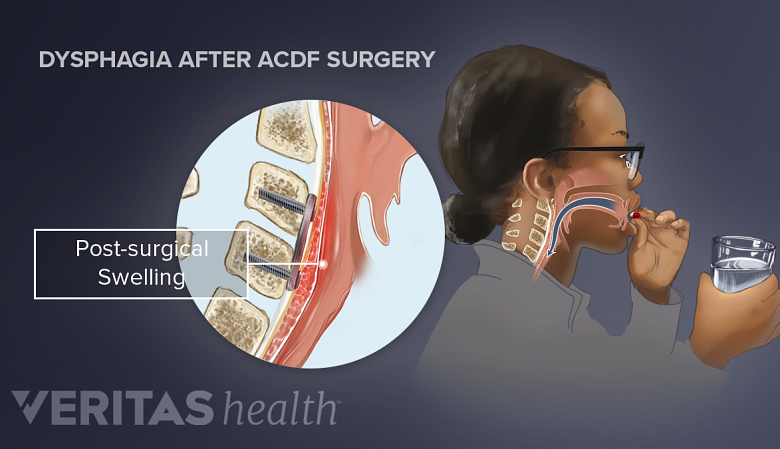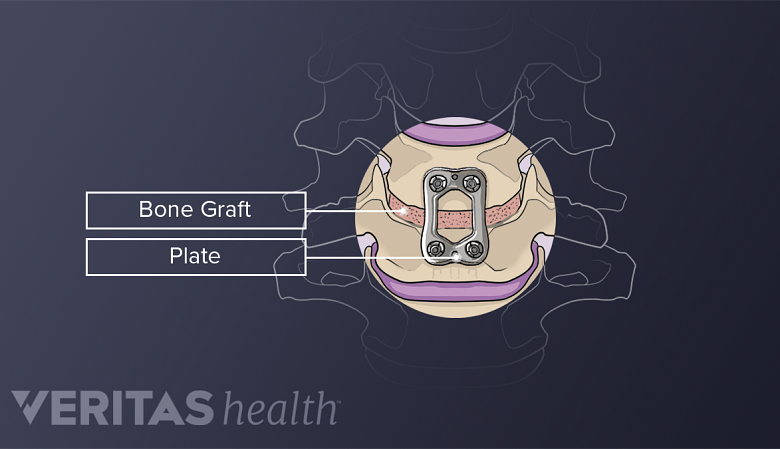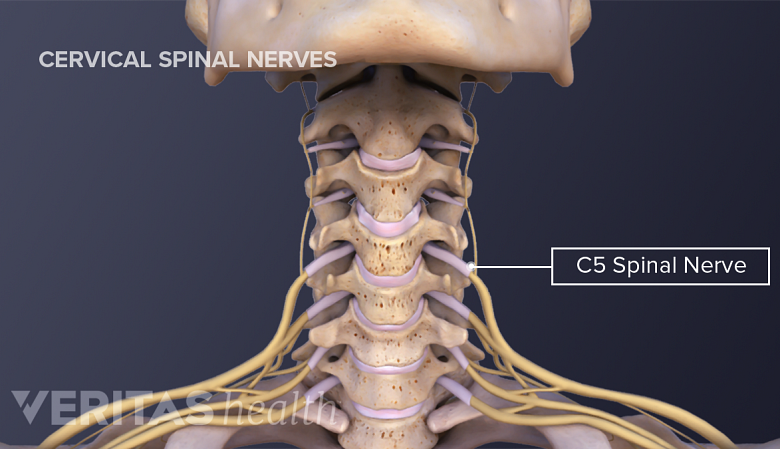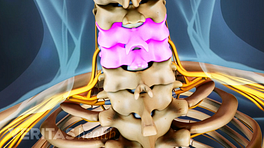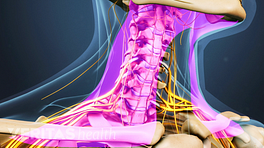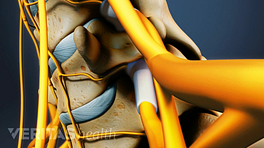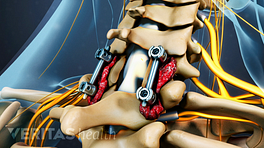Complications of cervical spine surgery span from rare instances of life-threatening conditions, like spinal cord injury and paralysis, to more common, self-limiting issues, such as dysphagia (difficulty swallowing). 1 Paziuk T, Rihn J. Cervical spine surgery: Complications and considerations. Seminars in Spine Surgery. 2019;31(4):100751. doi:10.1016/j.semss.2019.100751
The occurrence of these complications varies and depends on specific factors such as the surgical approach– anterior or posterior. 1 Paziuk T, Rihn J. Cervical spine surgery: Complications and considerations. Seminars in Spine Surgery. 2019;31(4):100751. doi:10.1016/j.semss.2019.100751
In This Article:
- Cervical Spine Surgery
- Pain Management and Activity Restrictions after Cervical Spine Surgery
- Potential Risks and Adverse Events Associated with Cervical Spine Surgery
Potential Risks and Complications of Anterior Approach Cervical Surgery
Operating on the left or right side either to the left or right of the esophagus or trachea is the most common approach. Risks associated with an anterior approach are:
Dysphagia
Dysphagia is a common complication of anterior cervical spine surgery.
Difficulty swallowing, medically called dysphagia, is one of the most common complications of anterior cervical spine surgery. 1 Paziuk T, Rihn J. Cervical spine surgery: Complications and considerations. Seminars in Spine Surgery. 2019;31(4):100751. doi:10.1016/j.semss.2019.100751
- Dysphagia occurs in almost 90% of anterior procedures and almost entirely resolves within a few weeks after surgery. 1 Paziuk T, Rihn J. Cervical spine surgery: Complications and considerations. Seminars in Spine Surgery. 2019;31(4):100751. doi:10.1016/j.semss.2019.100751 , 2 Yee TJ, Swong K, Park P. Complications of anterior cervical spine surgery: a systematic review of the literature. J Spine Surg. 2020;6(1):302-322. doi:10.21037/jss.2020.01.14
- The cause of dysphagia is a combination of irritation to the laryngeal nerve and swelling in the throat, which leads to a part of the tissue behind the tongue (epiglottis) turning inward when swallowing. 1 Paziuk T, Rihn J. Cervical spine surgery: Complications and considerations. Seminars in Spine Surgery. 2019;31(4):100751. doi:10.1016/j.semss.2019.100751
- Dysphagia increases the risk of aspiration, which refers to the accidental entry of food or other materials into the airway or lungs. Aspiration from dysphagia is seen in almost 50% of the patients with anterior cervical spine procedures. 1 Paziuk T, Rihn J. Cervical spine surgery: Complications and considerations. Seminars in Spine Surgery. 2019;31(4):100751. doi:10.1016/j.semss.2019.100751
The risk of dysphagia increases with procedures that involve prolonged intubation and retraction of the esophagus (food pipe), surgery at more than one level, obesity, and operating on upper cervical levels. 1 Paziuk T, Rihn J. Cervical spine surgery: Complications and considerations. Seminars in Spine Surgery. 2019;31(4):100751. doi:10.1016/j.semss.2019.100751
Dysphonia
Abnormal voice, medically called dysphonia, occurs in about 1% of anterior cervical procedures. 1 Paziuk T, Rihn J. Cervical spine surgery: Complications and considerations. Seminars in Spine Surgery. 2019;31(4):100751. doi:10.1016/j.semss.2019.100751
- Dysphonia arises from damage to the laryngeal and/or hypoglossal nerve in the neck. 1 Paziuk T, Rihn J. Cervical spine surgery: Complications and considerations. Seminars in Spine Surgery. 2019;31(4):100751. doi:10.1016/j.semss.2019.100751
- When present, the change in voice appears immediately after the surgery, but in rare cases, delayed onset dysphonia may occur, when the condition develops a few days or weeks after surgery. 1 Paziuk T, Rihn J. Cervical spine surgery: Complications and considerations. Seminars in Spine Surgery. 2019;31(4):100751. doi:10.1016/j.semss.2019.100751
- Dysphonia resolves on its own without specific treatment. 1 Paziuk T, Rihn J. Cervical spine surgery: Complications and considerations. Seminars in Spine Surgery. 2019;31(4):100751. doi:10.1016/j.semss.2019.100751
The risk of dysphonia increases with prolonged surgeries that involve intubation, which compresses the recurrent laryngeal nerve. 1 Paziuk T, Rihn J. Cervical spine surgery: Complications and considerations. Seminars in Spine Surgery. 2019;31(4):100751. doi:10.1016/j.semss.2019.100751
Pseudoarthrosis
Failure of spinal fusion, known as pseudoarthrosis, is seen in 2% of anterior cervical procedures, but not all patients develop symptoms. 1 Paziuk T, Rihn J. Cervical spine surgery: Complications and considerations. Seminars in Spine Surgery. 2019;31(4):100751. doi:10.1016/j.semss.2019.100751 , 2 Yee TJ, Swong K, Park P. Complications of anterior cervical spine surgery: a systematic review of the literature. J Spine Surg. 2020;6(1):302-322. doi:10.21037/jss.2020.01.14
The risk of pseudoarthrosis significantly decreases when anterior plate fixation is used with anterior cervical discectomy and fusion (ACDF) surgery. 1 Paziuk T, Rihn J. Cervical spine surgery: Complications and considerations. Seminars in Spine Surgery. 2019;31(4):100751. doi:10.1016/j.semss.2019.100751 , 2 Yee TJ, Swong K, Park P. Complications of anterior cervical spine surgery: a systematic review of the literature. J Spine Surg. 2020;6(1):302-322. doi:10.21037/jss.2020.01.14
The risk increases in multi-level fusions, older individuals, and pre-existing medical conditions such as uncontrolled diabetes, osteoporosis, and malnutrition.
Undesirable fusion
Fusion of the treated cervical segment is a rare complication of anterior cervical disc replacement, a surgical procedure intended to preserve motion in the neck.
In some cases of cervical disc replacement, the vertebrae fuse together, restricting motion. For these patients, fusion is not dangerous or serious, but it is an undesirable outcome. 3 Ge CY, Wang J, Zhang BF, et al. Spontaneous Fusion After Cervical Disc Arthroplasty: A Case Report and Literature Review. J Pain Res. 2020;13:771-776. Published 2020 Apr 21. doi:10.2147/JPR.S242646
See Potential Complications and Risks of Cervical Disc Replacement Surgery
Graft and hardware failure
Breakage of the hardware that secures the bone graft causes complications and the need for additional surgery.
Migration of the bone graft and/or complications related to spinal instrumentation, such as screw loosening or fracture, are seen in around 2% of anterior cervical procedures. 2 Yee TJ, Swong K, Park P. Complications of anterior cervical spine surgery: a systematic review of the literature. J Spine Surg. 2020;6(1):302-322. doi:10.21037/jss.2020.01.14
Research indicates that hardware failure is higher in cervical corpectomy (removal of the vertebra and disc) compared to ACDF. 2 Yee TJ, Swong K, Park P. Complications of anterior cervical spine surgery: a systematic review of the literature. J Spine Surg. 2020;6(1):302-322. doi:10.21037/jss.2020.01.14
Research indicates that around 22% of patients with this complication develop some degree of spinal cord injury and require revision surgery. 2 Yee TJ, Swong K, Park P. Complications of anterior cervical spine surgery: a systematic review of the literature. J Spine Surg. 2020;6(1):302-322. doi:10.21037/jss.2020.01.14
Injury to the vertebral artery
Damage to the delicate vertebral artery in the neck, a serious complication, occurs in less than 1% of anterior cervical surgeries. 1 Paziuk T, Rihn J. Cervical spine surgery: Complications and considerations. Seminars in Spine Surgery. 2019;31(4):100751. doi:10.1016/j.semss.2019.100751
- The vertebral arteries run through the transverse foramina in the cervical vertebrae, putting them at risk during anterior cervical procedures.
- Injury occurs from direct trauma by surgical instruments or retractors or indirectly from fracture fragments or improper screw placement.
- Outcomes of this injury range from asymptomatic vessel blockage to severe hemorrhage. Signs include significant blood loss, hemodynamic instability, stroke, and/or neurologic deficits.
The greatest risk for vertebral artery injury is an abnormal course of the artery, which is seen in 5.4% of the general population. Additionally, previous cervical surgery and/or pre-existing vascular conditions increase the risk of this complication. 1 Paziuk T, Rihn J. Cervical spine surgery: Complications and considerations. Seminars in Spine Surgery. 2019;31(4):100751. doi:10.1016/j.semss.2019.100751
Sympathetic nerve damage and Horner’s syndrome
Around 4% of anterior cervical spine procedures result in injury to the sympathetic nerve chain (a group of nerves near the middle of the cervical spine), a condition called Horner’s syndrome. 1 Paziuk T, Rihn J. Cervical spine surgery: Complications and considerations. Seminars in Spine Surgery. 2019;31(4):100751. doi:10.1016/j.semss.2019.100751
Trauma to these nerves causes neurological problems in the eye and face, such as drooping of the eyelid, constriction of the pupil, and swelling of the face. 1 Paziuk T, Rihn J. Cervical spine surgery: Complications and considerations. Seminars in Spine Surgery. 2019;31(4):100751. doi:10.1016/j.semss.2019.100751
While usually transient, Horner's syndrome is a distressing complication for patients.
Risks and Complications Common to Anterior and Posterior Approaches
In comparison to the anterior approach, the posterior approach is associated with higher blood loss, increased rates of wound complications, and a longer post-surgical recovery period. 1 Paziuk T, Rihn J. Cervical spine surgery: Complications and considerations. Seminars in Spine Surgery. 2019;31(4):100751. doi:10.1016/j.semss.2019.100751
Some risks are common to both these approaches and include:
C5 nerve palsy
Trauma to the C5 spinal nerve occurs in some cervical spine surgeries.
The C5 spinal nerve exits the intervertebral foramen at the C4-C5 spinal motion segment – where the inward curve of the cervical spine (lordosis) peaks. When spinal cord decompression surgery is performed at this level, there is a risk for the spinal cord to be pushed posteriorly (backward). While this migration does not cause any symptoms related to the spinal cord itself, it increases tension on the anatomically short C5 spinal nerve at this level. 1 Paziuk T, Rihn J. Cervical spine surgery: Complications and considerations. Seminars in Spine Surgery. 2019;31(4):100751. doi:10.1016/j.semss.2019.100751
C5 nerve palsy causes immediate or delayed symptoms that are characterized by weakness in the shoulder’s deltoid muscle. 1 Paziuk T, Rihn J. Cervical spine surgery: Complications and considerations. Seminars in Spine Surgery. 2019;31(4):100751. doi:10.1016/j.semss.2019.100751
Patients with excessive inward curvature of the cervical spine or those with circumferentially large spinal cords are at an increased risk for this complication. 1 Paziuk T, Rihn J. Cervical spine surgery: Complications and considerations. Seminars in Spine Surgery. 2019;31(4):100751. doi:10.1016/j.semss.2019.100751
Epidural hematoma
The pooling of blood in the area around the spinal cord is known as an epidural hematoma, a severe complication that can potentially lead to paralysis. The risk for this complication is rare and occurs in 0.1% to 3% of cervical spine surgeries. 1 Paziuk T, Rihn J. Cervical spine surgery: Complications and considerations. Seminars in Spine Surgery. 2019;31(4):100751. doi:10.1016/j.semss.2019.100751
Taking blood-thinning medication or non-steroidal anti-inflammatory drugs (NSAIDs) increases the risk of this complication by six-fold. 1 Paziuk T, Rihn J. Cervical spine surgery: Complications and considerations. Seminars in Spine Surgery. 2019;31(4):100751. doi:10.1016/j.semss.2019.100751
Adjacent segment disease
Cervical spinal fusion, such as ACDF, limits movement at the treated vertebral segments, which places extra mechanical stress on the mobile levels above and below the fused area. Over time, the increased forces are believed to accelerate degenerative changes at the adjacent segments, resulting in adjacent segment disease. 1 Paziuk T, Rihn J. Cervical spine surgery: Complications and considerations. Seminars in Spine Surgery. 2019;31(4):100751. doi:10.1016/j.semss.2019.100751 This issue is most often significantly decreased in patients undergoing cervical artificial disc replacement.
The likelihood of adjacent segment disease rises with multi-level fusions. In the cervical spine, opting for an anterior approach is linked to a threefold higher risk of encountering this complication. 1 Paziuk T, Rihn J. Cervical spine surgery: Complications and considerations. Seminars in Spine Surgery. 2019;31(4):100751. doi:10.1016/j.semss.2019.100751
Read more about Multilevel Fusion Risks
Thorough pre-surgical planning and surgical vigilance help reduce many of the possible complications associated with cervical spine surgery. Patients are advised to discuss the surgical risks, benefits, and alternatives with the surgeon before considering a spinal procedure.
- 1 Paziuk T, Rihn J. Cervical spine surgery: Complications and considerations. Seminars in Spine Surgery. 2019;31(4):100751. doi:10.1016/j.semss.2019.100751
- 2 Yee TJ, Swong K, Park P. Complications of anterior cervical spine surgery: a systematic review of the literature. J Spine Surg. 2020;6(1):302-322. doi:10.21037/jss.2020.01.14
- 3 Ge CY, Wang J, Zhang BF, et al. Spontaneous Fusion After Cervical Disc Arthroplasty: A Case Report and Literature Review. J Pain Res. 2020;13:771-776. Published 2020 Apr 21. doi:10.2147/JPR.S242646
